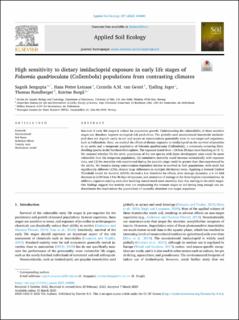| dc.contributor.author | Sengupta, Sagnik | |
| dc.contributor.author | Leinaas, Hans Petter | |
| dc.contributor.author | van Gestel, Cornelis A.M. | |
| dc.contributor.author | Jager, Tjalling | |
| dc.contributor.author | Rundberget, Thomas | |
| dc.contributor.author | Borgå, Katrine | |
| dc.date.accessioned | 2023-09-21T13:26:13Z | |
| dc.date.available | 2023-09-21T13:26:13Z | |
| dc.date.created | 2023-03-29T13:27:36Z | |
| dc.date.issued | 2023 | |
| dc.identifier.citation | Applied Soil Ecology. 2023, 187:104880, 1-7. | en_US |
| dc.identifier.issn | 0929-1393 | |
| dc.identifier.uri | https://hdl.handle.net/11250/3091119 | |
| dc.description.abstract | Survival of early life stages is critical for population growth. Understanding the vulnerability of these sensitive stages can therefore improve ecological risk predictions. The globally-used neonicotinoid insecticide imidacloprid does not degrade easily in soil and occurs at concentrations potentially toxic to non-target soil organisms, such as Collembola. Here, we studied the effects of dietary exposure to imidacloprid on the survival of juveniles in an arctic and a temperate population of Folsomia quadrioculata (Collembola), a commonly-occurring litter-dwelling species in the Northern Hemisphere. The exposure lasted from <24 h to 30 days since hatching at 15 °C. We assessed whether (1) the arctic population of the test species with faster development rates could be more vulnerable than the temperate population, (2) cumulative mortality could increase substantially with exposure time, and (3) the mortality risk experienced during the juvenile stage could be greater than that experienced by the adults. We found a strong concentration-dependent decline in survival in both populations, with small but significantly different LC50s, despite large differences in multiple life-history traits. Applying a General Unified Threshold model for Survival (GUTS) showed a low threshold for effects, slow damage dynamics, a 6–11-fold decrease in LC50 from 14 to 30 days of exposure, and saturation of damage at the three highest concentrations. In addition, exposure starting soon after hatching caused much more mortality than that starting in the adult stages. Our findings suggest that toxicity tests not emphasizing the neonate stages or not lasting long enough can underestimate the implications for populations of naturally abundant non-target organisms. | en_US |
| dc.language.iso | eng | en_US |
| dc.publisher | Elsevier | en_US |
| dc.rights | Navngivelse 4.0 Internasjonal | * |
| dc.rights.uri | http://creativecommons.org/licenses/by/4.0/deed.no | * |
| dc.title | High sensitivity to dietary imidacloprid exposure in early life stages of Folsomia quadrioculata (Collembola) populations from contrasting climates | en_US |
| dc.type | Peer reviewed | en_US |
| dc.type | Journal article | en_US |
| dc.description.version | publishedVersion | en_US |
| dc.rights.holder | © 2023 The Authors | en_US |
| dc.source.pagenumber | 7 | en_US |
| dc.source.volume | 187 | en_US |
| dc.source.journal | Applied Soil Ecology | en_US |
| dc.identifier.doi | 10.1016/j.apsoil.2023.104880 | |
| dc.identifier.cristin | 2138139 | |
| dc.source.articlenumber | 104880 | en_US |
| cristin.ispublished | true | |
| cristin.fulltext | original | |
| cristin.qualitycode | 1 | |

